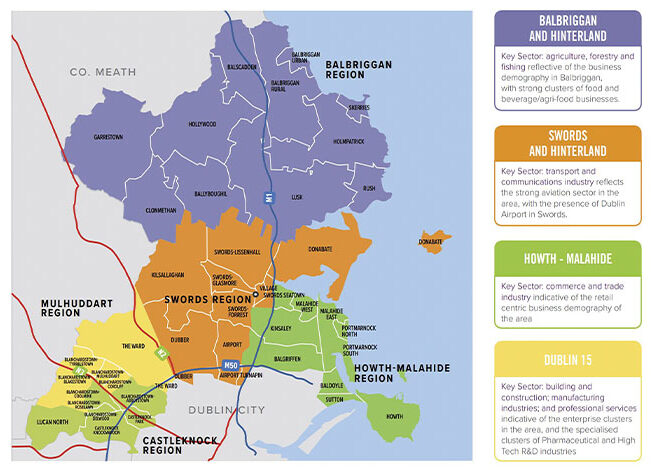Fingal skills strategy making a real impact

In 2019, Fingal County Council became the first local authority in Ireland to develop a skills strategy and five years on it is making a real impact across the county.
The purpose of the strategy is to identify gaps between the skills of Fingal’s workforce and skills that employers need. It sets out specific actions, such as developing new training courses, increasing course provision, and building relationships with employers, educational institutions and other stakeholders.
Analysis carried out in 2018 showed a skills gap of up to 7,600 roles per annum up to 2023. These were broken down across sectors and occupations with six key sectors identified for the county:
- commerce and trade;
- professional services;
- transport and logistics;
- manufacturing/biopharma;
- agri-food; and
- construction.
The strategy set out recommendations to be carried out by both the public and private sector working in partnership. Implementation was disrupted by the Covid-19 pandemic but in 2021, the Skills Strategy Implementation Group convened to review developments in key sectors in a post-Covid environment and drive activities to facilitate skills development and increase awareness of training and education opportunities.
Fingal County Council actively engaged with education providers and industry stakeholders to establish four sectoral subgroups in construction, transport and logistics, green skills, and services to focus on the specific needs of businesses in that sector. The Council has ambitious plans to expand the membership of existing subgroups and break into new sectors with companies eager to replicate the success of the companies already involved.
As a result of these engagements, involving over 40 individual businesses and 12 education providers, a feedback mechanism has been developed. This gives organisations a means to communicate their needs to education providers through the adaptation of existing courses, signposting to provision, and through increased opportunities.
One of those companies was the Swords-based Riot Games. Discussions with the company facilitated by the council and Fingal Chamber Skillnet identified their immediate and future skills needs. This has led to Dublin City University and Technological University Dublin exploring delivery of a special purpose award for a short intensive course to upskill degree graduates from broadcast engineering disciplines in order to meet Riot Games’ business needs.
The Mayor of Fingal, Adrian Henchy, said: “As investment in Fingal continues to grow, it is very important that we safeguard this with a pipeline of workers with the right skills to fill future vacancies. With the county’s young age profile and competitive advantages in terms of enterprise, Fingal is very well placed to capitalise on this work. The strategy also puts in place a roadmap for people who may not have a high level of educational attainment, but who wish to embark on employment or upskill through further education.”
Secondary school students who are deciding on what career they should pursue after completing their Leaving Certificate are also being supported through the Skills Strategy. A pilot mentoring programme was run in four secondary schools in Balbriggan with 12 volunteers from local businesses in Fingal being trained in the Trinity Access Programme to mentor students and make them aware of future potential career options.
In October 2023, Fingal County Council, in partnership with Dublin City University (DCU), Dublin Regional Skills Forum (DRSF), Solas, NTO, DDLETB, CTETB and TU Dublin hosted the inaugural Xplore Your Future Skills Expo at The Helix. The ground-breaking initiative, organised as part of the Fingal Skills Strategy and the European Year of Skills 2023, attracted some 1,600 Transition Year students from Fingal and encouraged them to consider their educational and career prospects.

The Expo featured a diverse range of more than 70 exhibitors, including leading education providers, industry professionals, and career experts from private companies, all eager to share their knowledge and insights with the attendees.
The Fingal Skills Strategy was initially funded by Fingal County Council but the Council has been successful in accessing Interreg Europe funding to review and refresh the Fingal Skills Strategy as a partner in Project SKYLA. Project SKYLA is a consortium of 11 regional partners, led by Italy and including organisations from Sweden, Poland, Lithuania, Bulgaria, Greece, Belgium, and Fingal in Ireland.
Over a time horizon to 2027, Project SKYLA seeks to boost and adapt the role of Vocational Education Training in territorial innovation ecosystems and smart specialisation strategies through the exchange and implementation of good practices between the partners. This partnership is bearing fruit, building new relationships with DDLETB, Fingal Chamber and Fingal LEO and European partners in a new Erasmus project to upskill SME’s in Corporate Digital Responsibility.
The Chief Executive of Fingal County Council, AnnMarie Farrelly, says: “In order to retain and attract companies that can provide employment within our county it is important we have a labour pool with the skills that are needed. The Fingal Skills Strategy has allowed us to identify where the gaps and opportunities are and our education partners have responded by providing the necessary courses to upskill people. It is a great example of what can be done when you bring the right people together to address an issue.”

W: www.fingal.ie/skills-strategy





